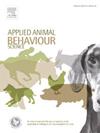Elastic motivation for circuit running behaviour in captive African striped mice Rhabdomys dilectus: A consumer demand approach
IF 2.2
2区 农林科学
Q1 AGRICULTURE, DAIRY & ANIMAL SCIENCE
引用次数: 0
Abstract
Captive environments often result in repetitive locomotor behaviours in animals, yet the motivation for these behaviours remains poorly understood. We investigated whether circuit running in African striped mice Rhabdomys dilectus represents a necessary coping mechanism or a flexible, cost-sensitive behaviour, which we tested using a consumer demand framework. Twenty mice displaying circuit running were individually housed in cages that limited this behaviour. Mice accessed a test chamber by travelling through a short (low-cost, Lc) or long (high-cost, Hc) connecting pipe, with the incentive value manipulated to create either a large (high, Hi) or small (low, Li) space, creating four treatments: LcHi, LcLi, HcHi, and HcLi. Mice displayed a higher proportion of circuit running in treatments with greater incentives (LcHi, HcHi) compared to those with restricted space (LcLi, HcLi), and the duration spent in the test chamber followed a graded pattern (LcHi > LcLi > HcHi > HcLi). Demand was classified as elastic or inelastic based on changes in behaviour relative to cost. Circuit running decreased as costs increased, indicating an elastic demand. Our findings indicate that circuit running in R. dilectus is flexible rather than fixed, challenging the interpretations of repetitive behaviour as an inflexible coping response. Our study also demonstrates the value of economic models for assessing behavioural motivation in captivity and suggest that repetitive locomotor behaviours may serve adaptive, facultative functions under constrained conditions.
圈养非洲斑纹鼠回路运行行为的弹性动机:一种消费者需求方法
圈养环境经常导致动物的重复运动行为,但这些行为的动机仍然知之甚少。我们研究了非洲条纹鼠横纹肌的回路运行是一种必要的应对机制还是一种灵活的、对成本敏感的行为,我们使用消费者需求框架进行了测试。20只表现出电路运行的老鼠被单独关在限制这种行为的笼子里。小鼠通过短(低成本,Lc)或长(高成本,Hc)连接管道进入实验室,通过操纵激励值来创建大(高,Hi)或小(低,Li)空间,创建四种处理:LcHi, LcLi, HcHi和HcLi。与空间有限的小鼠(LcLi, HcLi)相比,在激励更大的处理(LcHi, HcHi)中,小鼠表现出更高的回路运行比例,并且在测试室中花费的时间遵循分级模式(LcHi >;LcLi祝辞HcHi祝辞HcLi)。根据与成本相关的行为变化,将需求分为弹性需求和非弹性需求。电路运行随着成本的增加而减少,表明需求具有弹性。我们的研究结果表明,直颈鼠的神经回路是灵活的,而不是固定的,这挑战了将重复行为解释为不灵活的应对反应的解释。我们的研究还证明了经济模型在评估圈养动物行为动机方面的价值,并表明在受限条件下,重复性运动行为可能具有适应性和兼性功能。
本文章由计算机程序翻译,如有差异,请以英文原文为准。
求助全文
约1分钟内获得全文
求助全文
来源期刊

Applied Animal Behaviour Science
农林科学-行为科学
CiteScore
4.40
自引率
21.70%
发文量
191
审稿时长
18.1 weeks
期刊介绍:
This journal publishes relevant information on the behaviour of domesticated and utilized animals.
Topics covered include:
-Behaviour of farm, zoo and laboratory animals in relation to animal management and welfare
-Behaviour of companion animals in relation to behavioural problems, for example, in relation to the training of dogs for different purposes, in relation to behavioural problems
-Studies of the behaviour of wild animals when these studies are relevant from an applied perspective, for example in relation to wildlife management, pest management or nature conservation
-Methodological studies within relevant fields
The principal subjects are farm, companion and laboratory animals, including, of course, poultry. The journal also deals with the following animal subjects:
-Those involved in any farming system, e.g. deer, rabbits and fur-bearing animals
-Those in ANY form of confinement, e.g. zoos, safari parks and other forms of display
-Feral animals, and any animal species which impinge on farming operations, e.g. as causes of loss or damage
-Species used for hunting, recreation etc. may also be considered as acceptable subjects in some instances
-Laboratory animals, if the material relates to their behavioural requirements
 求助内容:
求助内容: 应助结果提醒方式:
应助结果提醒方式:


